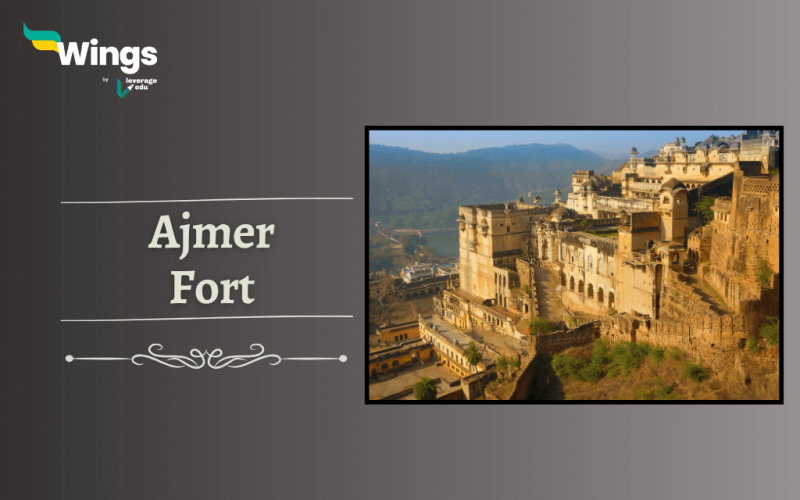Ajmer Fort is originally called Taragarh Fort and Ajaymeru Durg and is also known as Star Fort. It is located in the Ajmer district of Rajasthan. It stands proudly atop the Aravalli Mountain range and is surrounded by lush green beauty all around. Built in the 8th century, this magnificent fortress holds within its walls centuries of history and a wealth of cultural significance. Let’s delve into the details of Ajmer Fort history and discover the intriguing tales that lie behind its ancient ramparts.
Table of Contents
| Commissioned by | Ajay Pal Chauhan |
| Also Known as | Taragarh Fort;Star Fort |
| Location | Ajmer, Rajasthan |
| Timings | 9:00 am to 7:00 pm; Open Everyday |
| Entry Fee for fort | Free Entry |
| Camera | Free |
History of Ajmer Fort
Ajmer Fort was built in the 8th century by Ajay Pal Chauhan and has witnessed centuries of history, battles, and rulers.
- The fort witnessed its first significant battle in 724 CE when King Durlabhraj I of the Chauhans bravely defended it against the Muslim armies led by Caliph Hisham ibn Abd al-Malik.
- The fort witnessed the first-ever tragic practice of Jauhar (self-immolation) by the Rajput women during this siege in India’s history.
- Prithviraj who was the son of Rana Raima of Mewar along with his elder brother Rana Sangha captured the fort around the 15th century by murdering Governor Mallu Khan.
- However, the fort was later seized by the Mughals and Mughal Emperor Akbar further strengthened the fort in the 16th century, incorporating elements of Rajput and Mughal architecture, evident in some of the remaining structures.
- Further, Lord William Bentinck took the fort under his control.
- When the British Raj took control in the 19th century, they dismantled parts of the fort, repurposing it as a sanatorium for their troops.
Features of Ajmer Fort
The architecture of Ajmer Fort reflects a blend of Rajput and Mughal styles, with massive stone walls, bastions, and intricately carved gates.
- Impregnable Walls: The fort is surrounded by thick stone walls that provided protection against invaders and enemy attacks. The walls are adorned with intricate carvings and embellishments, showcasing the skilled craftsmanship of the artisans.
- Taragarh Fort: The fort is also known as Taragarh Fort, which means the “Star Fort.” It derives its name from its location on top of a hill, resembling a shining star when viewed from a distance.
Another tale is the name comes from Prithviraj’s mother named – Tarabai and thus was named Taragarh.
- Rani Mahal: Within the fort complex, there is a beautifully preserved palace known as Rani Mahal, which once served as the residence of the royal women. The palace boasts stunning architecture and intricate designs, offering a glimpse into the luxurious lifestyle of the royals.
- Gates – There are three gates known as Lakshmi Pol, Phuta Darwaza and Gagudi Ki Phatak.
- Miran Saheb ki Dargah: Ajmer Fort also boasts of Miran Saheb ki Dargah. Miran Saheb was the garrison commander of the fort and lost his life in a Rajput attack in the year 1202 CE.
Though the fort is now in shambles, it once was adorned with 14 bastions and large gateways.
Also Read – Palakkad Fort History: Features, Facts, Timings & More
Fascinating Facts About Ajmer Fort
- Ajmer Fort played a crucial role in the history of Rajasthan, witnessing several battles and power struggles over the centuries.
- Taragarh Fort is believed to be connected to the nearby Ajmer Sharif Dargah by a secret passage, though its existence hasn’t been definitively proven.
- The fort stands as a symbol of Rajasthan’s rich cultural heritage and architectural finesses with tunnels in crisscross sections, which once served as a hideout during attacks.
Also Read – Aguada Fort History: Features, Facts, Timings & More
Timings of Ajmer Fort
The timings for visiting the Monument and watching the mesmerising views are as –
| Purpose | Timings |
| Entry | 9:00 am to 7:00 pm |
| Week Entry | Everyday |
| Entry Fee | Free |
| Camera | Free |
After India’s independence, the fort was brought under the control of the Archaeological Survey of India (ASI) and has since become a popular tourist destination. The “Magazine,” which was built by the Mughals, stands as a documentation to their architectural prowess, while the “Killa Maidan” (fort ground) offers panoramic views of the surrounding city.
Other Attractions near Ajmer Fort
| Ajmer Sharif Dargah | Adhai-din-ka-Jhonpra |
| Ana Sagar Lake | Durga Bagh Garden |
| Akbar’s Palace | Foy Sagar Lake |
| Prithviraj Smarak | Sambhar Lake |
Relevant Blogs
That’s all about Ajmer Fort history! If you want to know more about topics like this, then visit our general knowledge page! Alternatively, you can also read our blog on general knowledge for competitive exams!
 One app for all your study abroad needs
One app for all your study abroad needs













